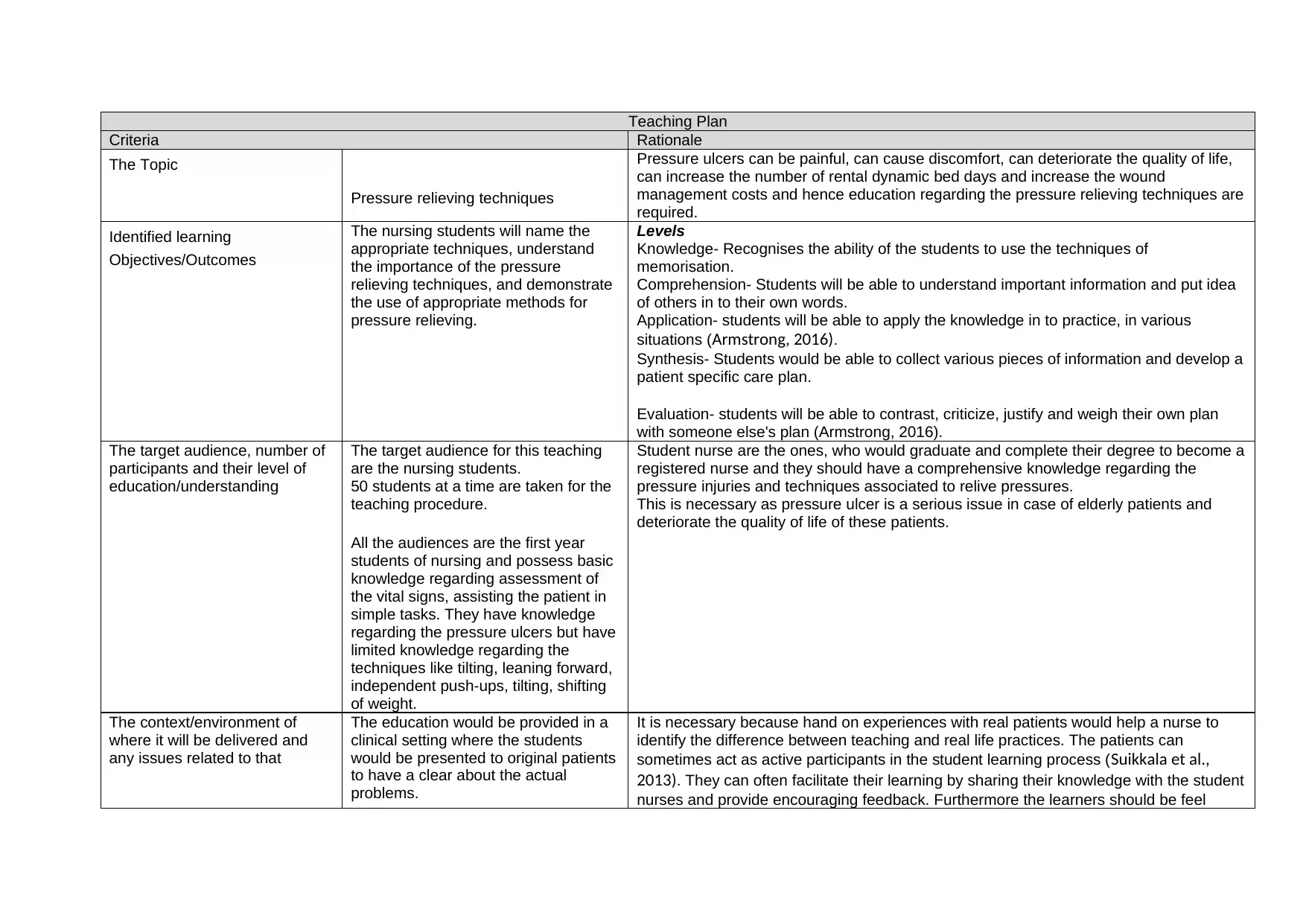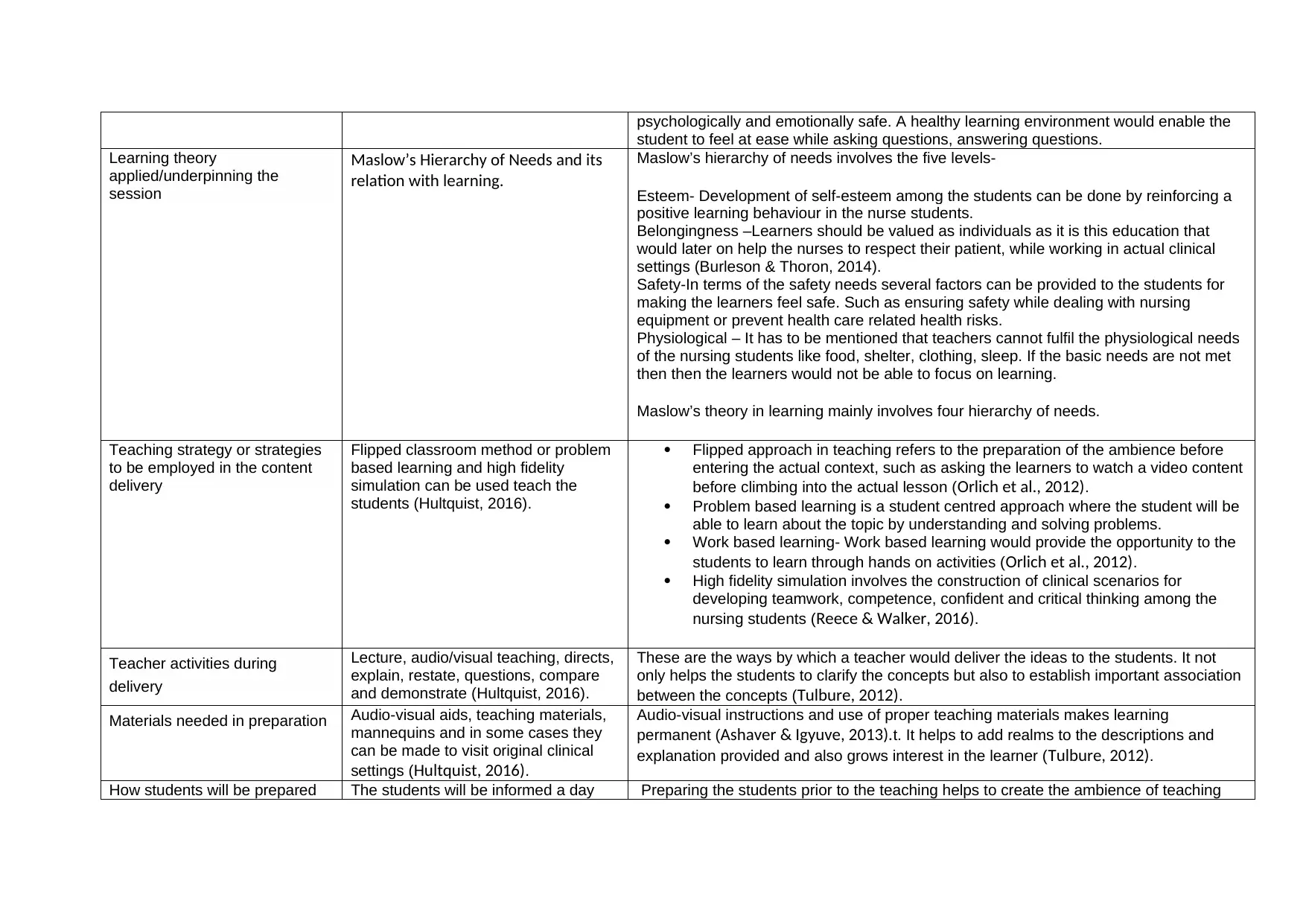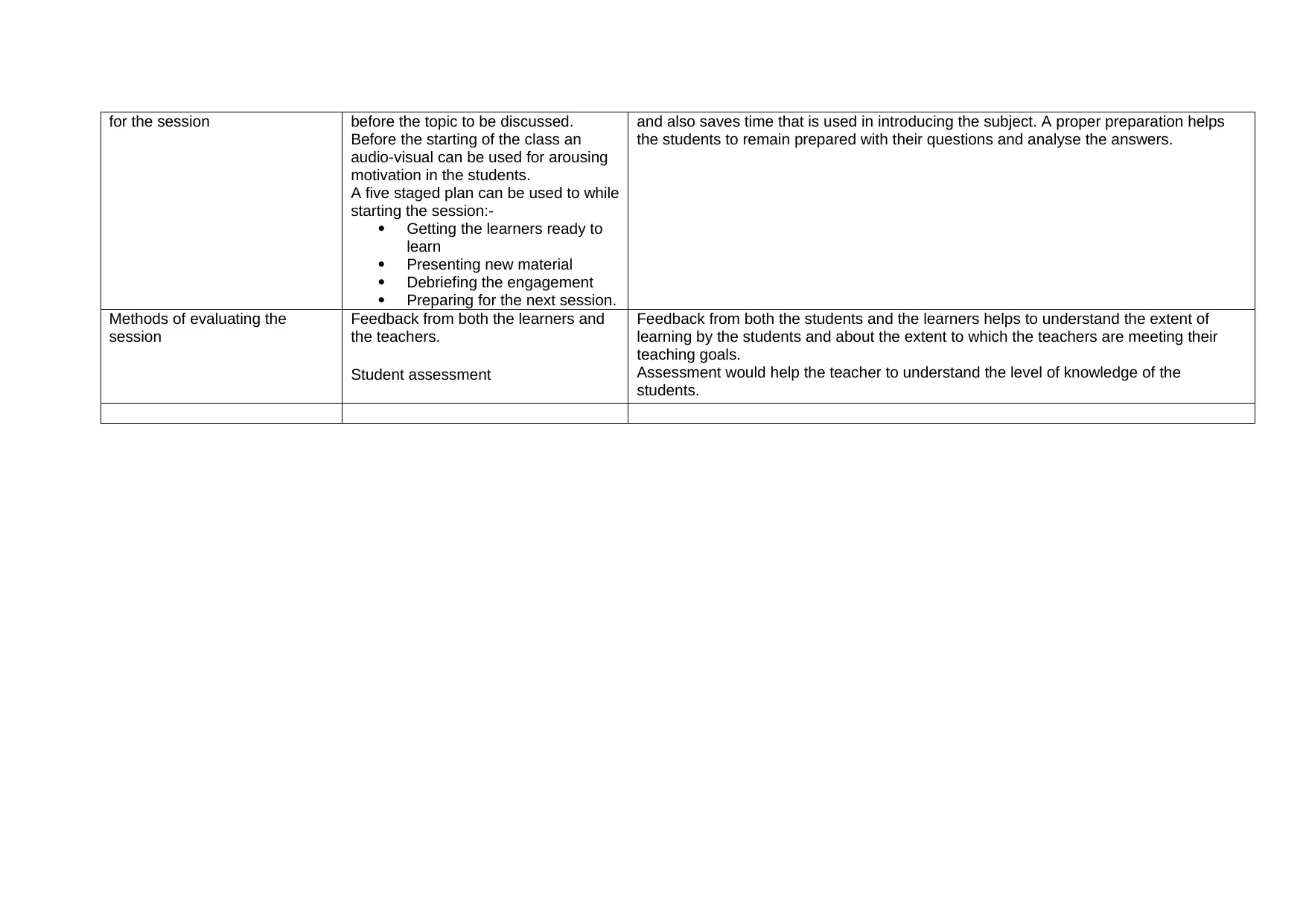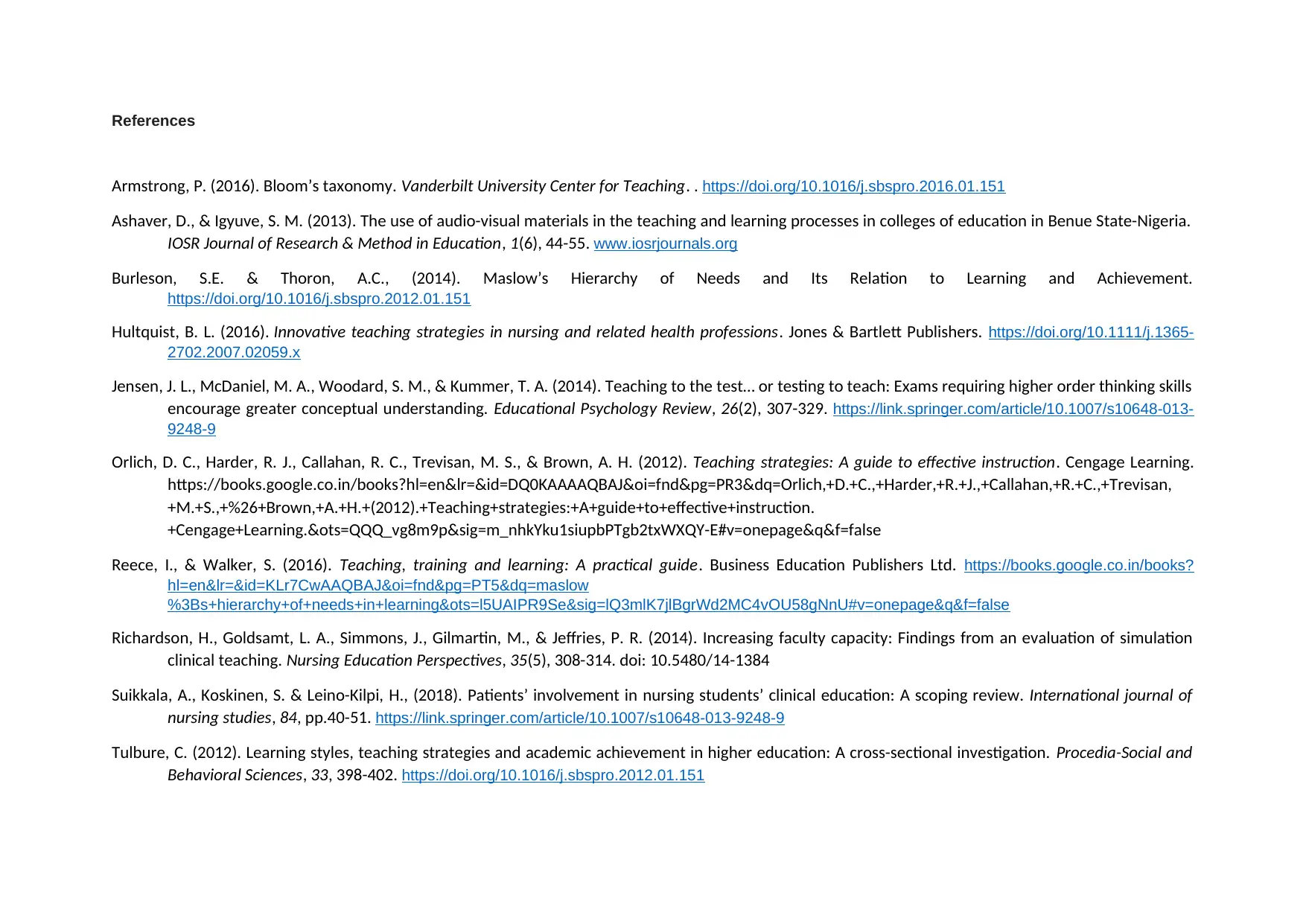Developing a Teaching Plan: Pressure Relieving Techniques for Nurses
VerifiedAdded on 2023/06/08
|4
|1605
|124
Report
AI Summary
This report presents a comprehensive teaching plan designed to educate nursing students on pressure relieving techniques. The plan outlines the learning objectives, which include understanding the importance of these techniques and demonstrating their application. The target audience is first-year nursing students, with a clinical setting being the primary environment for delivery. The rationale emphasizes the significance of pressure relieving techniques in preventing pressure ulcers and improving patient outcomes. The plan incorporates Maslow’s Hierarchy of Needs to create a supportive learning environment, and employs teaching strategies like the flipped classroom method, problem-based learning, and high-fidelity simulation. Evaluation methods include pre-class motivation, feedback, and student assessment to gauge the effectiveness of the teaching session. The plan also details the materials needed, how students will be prepared, and the activities of the teacher during the teaching. References to support the plan are also included.

Teaching Plan
Criteria Rationale
The Topic
Pressure relieving techniques
Pressure ulcers can be painful, can cause discomfort, can deteriorate the quality of life,
can increase the number of rental dynamic bed days and increase the wound
management costs and hence education regarding the pressure relieving techniques are
required.
Identified learning
Objectives/Outcomes
The nursing students will name the
appropriate techniques, understand
the importance of the pressure
relieving techniques, and demonstrate
the use of appropriate methods for
pressure relieving.
Levels
Knowledge- Recognises the ability of the students to use the techniques of
memorisation.
Comprehension- Students will be able to understand important information and put idea
of others in to their own words.
Application- students will be able to apply the knowledge in to practice, in various
situations (Armstrong, 2016).
Synthesis- Students would be able to collect various pieces of information and develop a
patient specific care plan.
Evaluation- students will be able to contrast, criticize, justify and weigh their own plan
with someone else's plan (Armstrong, 2016).
The target audience, number of
participants and their level of
education/understanding
The target audience for this teaching
are the nursing students.
50 students at a time are taken for the
teaching procedure.
All the audiences are the first year
students of nursing and possess basic
knowledge regarding assessment of
the vital signs, assisting the patient in
simple tasks. They have knowledge
regarding the pressure ulcers but have
limited knowledge regarding the
techniques like tilting, leaning forward,
independent push-ups, tilting, shifting
of weight.
Student nurse are the ones, who would graduate and complete their degree to become a
registered nurse and they should have a comprehensive knowledge regarding the
pressure injuries and techniques associated to relive pressures.
This is necessary as pressure ulcer is a serious issue in case of elderly patients and
deteriorate the quality of life of these patients.
The context/environment of
where it will be delivered and
any issues related to that
The education would be provided in a
clinical setting where the students
would be presented to original patients
to have a clear about the actual
problems.
It is necessary because hand on experiences with real patients would help a nurse to
identify the difference between teaching and real life practices. The patients can
sometimes act as active participants in the student learning process (Suikkala et al.,
2013). They can often facilitate their learning by sharing their knowledge with the student
nurses and provide encouraging feedback. Furthermore the learners should be feel
Criteria Rationale
The Topic
Pressure relieving techniques
Pressure ulcers can be painful, can cause discomfort, can deteriorate the quality of life,
can increase the number of rental dynamic bed days and increase the wound
management costs and hence education regarding the pressure relieving techniques are
required.
Identified learning
Objectives/Outcomes
The nursing students will name the
appropriate techniques, understand
the importance of the pressure
relieving techniques, and demonstrate
the use of appropriate methods for
pressure relieving.
Levels
Knowledge- Recognises the ability of the students to use the techniques of
memorisation.
Comprehension- Students will be able to understand important information and put idea
of others in to their own words.
Application- students will be able to apply the knowledge in to practice, in various
situations (Armstrong, 2016).
Synthesis- Students would be able to collect various pieces of information and develop a
patient specific care plan.
Evaluation- students will be able to contrast, criticize, justify and weigh their own plan
with someone else's plan (Armstrong, 2016).
The target audience, number of
participants and their level of
education/understanding
The target audience for this teaching
are the nursing students.
50 students at a time are taken for the
teaching procedure.
All the audiences are the first year
students of nursing and possess basic
knowledge regarding assessment of
the vital signs, assisting the patient in
simple tasks. They have knowledge
regarding the pressure ulcers but have
limited knowledge regarding the
techniques like tilting, leaning forward,
independent push-ups, tilting, shifting
of weight.
Student nurse are the ones, who would graduate and complete their degree to become a
registered nurse and they should have a comprehensive knowledge regarding the
pressure injuries and techniques associated to relive pressures.
This is necessary as pressure ulcer is a serious issue in case of elderly patients and
deteriorate the quality of life of these patients.
The context/environment of
where it will be delivered and
any issues related to that
The education would be provided in a
clinical setting where the students
would be presented to original patients
to have a clear about the actual
problems.
It is necessary because hand on experiences with real patients would help a nurse to
identify the difference between teaching and real life practices. The patients can
sometimes act as active participants in the student learning process (Suikkala et al.,
2013). They can often facilitate their learning by sharing their knowledge with the student
nurses and provide encouraging feedback. Furthermore the learners should be feel
Paraphrase This Document
Need a fresh take? Get an instant paraphrase of this document with our AI Paraphraser

psychologically and emotionally safe. A healthy learning environment would enable the
student to feel at ease while asking questions, answering questions.
Learning theory
applied/underpinning the
session
Maslow’s Hierarchy of Needs and its
relation with learning.
Maslow’s hierarchy of needs involves the five levels-
Esteem- Development of self-esteem among the students can be done by reinforcing a
positive learning behaviour in the nurse students.
Belongingness –Learners should be valued as individuals as it is this education that
would later on help the nurses to respect their patient, while working in actual clinical
settings (Burleson & Thoron, 2014).
Safety-In terms of the safety needs several factors can be provided to the students for
making the learners feel safe. Such as ensuring safety while dealing with nursing
equipment or prevent health care related health risks.
Physiological – It has to be mentioned that teachers cannot fulfil the physiological needs
of the nursing students like food, shelter, clothing, sleep. If the basic needs are not met
then then the learners would not be able to focus on learning.
Maslow’s theory in learning mainly involves four hierarchy of needs.
Teaching strategy or strategies
to be employed in the content
delivery
Flipped classroom method or problem
based learning and high fidelity
simulation can be used teach the
students (Hultquist, 2016).
Flipped approach in teaching refers to the preparation of the ambience before
entering the actual context, such as asking the learners to watch a video content
before climbing into the actual lesson (Orlich et al., 2012).
Problem based learning is a student centred approach where the student will be
able to learn about the topic by understanding and solving problems.
Work based learning- Work based learning would provide the opportunity to the
students to learn through hands on activities (Orlich et al., 2012).
High fidelity simulation involves the construction of clinical scenarios for
developing teamwork, competence, confident and critical thinking among the
nursing students (Reece & Walker, 2016).
Teacher activities during
delivery
Lecture, audio/visual teaching, directs,
explain, restate, questions, compare
and demonstrate (Hultquist, 2016).
These are the ways by which a teacher would deliver the ideas to the students. It not
only helps the students to clarify the concepts but also to establish important association
between the concepts (Tulbure, 2012).
Materials needed in preparation Audio-visual aids, teaching materials,
mannequins and in some cases they
can be made to visit original clinical
settings (Hultquist, 2016).
Audio-visual instructions and use of proper teaching materials makes learning
permanent (Ashaver & Igyuve, 2013).t. It helps to add realms to the descriptions and
explanation provided and also grows interest in the learner (Tulbure, 2012).
How students will be prepared The students will be informed a day Preparing the students prior to the teaching helps to create the ambience of teaching
student to feel at ease while asking questions, answering questions.
Learning theory
applied/underpinning the
session
Maslow’s Hierarchy of Needs and its
relation with learning.
Maslow’s hierarchy of needs involves the five levels-
Esteem- Development of self-esteem among the students can be done by reinforcing a
positive learning behaviour in the nurse students.
Belongingness –Learners should be valued as individuals as it is this education that
would later on help the nurses to respect their patient, while working in actual clinical
settings (Burleson & Thoron, 2014).
Safety-In terms of the safety needs several factors can be provided to the students for
making the learners feel safe. Such as ensuring safety while dealing with nursing
equipment or prevent health care related health risks.
Physiological – It has to be mentioned that teachers cannot fulfil the physiological needs
of the nursing students like food, shelter, clothing, sleep. If the basic needs are not met
then then the learners would not be able to focus on learning.
Maslow’s theory in learning mainly involves four hierarchy of needs.
Teaching strategy or strategies
to be employed in the content
delivery
Flipped classroom method or problem
based learning and high fidelity
simulation can be used teach the
students (Hultquist, 2016).
Flipped approach in teaching refers to the preparation of the ambience before
entering the actual context, such as asking the learners to watch a video content
before climbing into the actual lesson (Orlich et al., 2012).
Problem based learning is a student centred approach where the student will be
able to learn about the topic by understanding and solving problems.
Work based learning- Work based learning would provide the opportunity to the
students to learn through hands on activities (Orlich et al., 2012).
High fidelity simulation involves the construction of clinical scenarios for
developing teamwork, competence, confident and critical thinking among the
nursing students (Reece & Walker, 2016).
Teacher activities during
delivery
Lecture, audio/visual teaching, directs,
explain, restate, questions, compare
and demonstrate (Hultquist, 2016).
These are the ways by which a teacher would deliver the ideas to the students. It not
only helps the students to clarify the concepts but also to establish important association
between the concepts (Tulbure, 2012).
Materials needed in preparation Audio-visual aids, teaching materials,
mannequins and in some cases they
can be made to visit original clinical
settings (Hultquist, 2016).
Audio-visual instructions and use of proper teaching materials makes learning
permanent (Ashaver & Igyuve, 2013).t. It helps to add realms to the descriptions and
explanation provided and also grows interest in the learner (Tulbure, 2012).
How students will be prepared The students will be informed a day Preparing the students prior to the teaching helps to create the ambience of teaching

for the session before the topic to be discussed.
Before the starting of the class an
audio-visual can be used for arousing
motivation in the students.
A five staged plan can be used to while
starting the session:-
Getting the learners ready to
learn
Presenting new material
Debriefing the engagement
Preparing for the next session.
and also saves time that is used in introducing the subject. A proper preparation helps
the students to remain prepared with their questions and analyse the answers.
Methods of evaluating the
session
Feedback from both the learners and
the teachers.
Student assessment
Feedback from both the students and the learners helps to understand the extent of
learning by the students and about the extent to which the teachers are meeting their
teaching goals.
Assessment would help the teacher to understand the level of knowledge of the
students.
Before the starting of the class an
audio-visual can be used for arousing
motivation in the students.
A five staged plan can be used to while
starting the session:-
Getting the learners ready to
learn
Presenting new material
Debriefing the engagement
Preparing for the next session.
and also saves time that is used in introducing the subject. A proper preparation helps
the students to remain prepared with their questions and analyse the answers.
Methods of evaluating the
session
Feedback from both the learners and
the teachers.
Student assessment
Feedback from both the students and the learners helps to understand the extent of
learning by the students and about the extent to which the teachers are meeting their
teaching goals.
Assessment would help the teacher to understand the level of knowledge of the
students.
⊘ This is a preview!⊘
Do you want full access?
Subscribe today to unlock all pages.

Trusted by 1+ million students worldwide

References
Armstrong, P. (2016). Bloom’s taxonomy. Vanderbilt University Center for Teaching. . https://doi.org/10.1016/j.sbspro.2016.01.151
Ashaver, D., & Igyuve, S. M. (2013). The use of audio-visual materials in the teaching and learning processes in colleges of education in Benue State-Nigeria.
IOSR Journal of Research & Method in Education, 1(6), 44-55. www.iosrjournals.org
Burleson, S.E. & Thoron, A.C., (2014). Maslow’s Hierarchy of Needs and Its Relation to Learning and Achievement.
https://doi.org/10.1016/j.sbspro.2012.01.151
Hultquist, B. L. (2016). Innovative teaching strategies in nursing and related health professions. Jones & Bartlett Publishers. https://doi.org/10.1111/j.1365-
2702.2007.02059.x
Jensen, J. L., McDaniel, M. A., Woodard, S. M., & Kummer, T. A. (2014). Teaching to the test… or testing to teach: Exams requiring higher order thinking skills
encourage greater conceptual understanding. Educational Psychology Review, 26(2), 307-329. https://link.springer.com/article/10.1007/s10648-013-
9248-9
Orlich, D. C., Harder, R. J., Callahan, R. C., Trevisan, M. S., & Brown, A. H. (2012). Teaching strategies: A guide to effective instruction. Cengage Learning.
https://books.google.co.in/books?hl=en&lr=&id=DQ0KAAAAQBAJ&oi=fnd&pg=PR3&dq=Orlich,+D.+C.,+Harder,+R.+J.,+Callahan,+R.+C.,+Trevisan,
+M.+S.,+%26+Brown,+A.+H.+(2012).+Teaching+strategies:+A+guide+to+effective+instruction.
+Cengage+Learning.&ots=QQQ_vg8m9p&sig=m_nhkYku1siupbPTgb2txWXQY-E#v=onepage&q&f=false
Reece, I., & Walker, S. (2016). Teaching, training and learning: A practical guide. Business Education Publishers Ltd. https://books.google.co.in/books?
hl=en&lr=&id=KLr7CwAAQBAJ&oi=fnd&pg=PT5&dq=maslow
%3Bs+hierarchy+of+needs+in+learning&ots=l5UAIPR9Se&sig=lQ3mlK7jlBgrWd2MC4vOU58gNnU#v=onepage&q&f=false
Richardson, H., Goldsamt, L. A., Simmons, J., Gilmartin, M., & Jeffries, P. R. (2014). Increasing faculty capacity: Findings from an evaluation of simulation
clinical teaching. Nursing Education Perspectives, 35(5), 308-314. doi: 10.5480/14-1384
Suikkala, A., Koskinen, S. & Leino-Kilpi, H., (2018). Patients’ involvement in nursing students’ clinical education: A scoping review. International journal of
nursing studies, 84, pp.40-51. https://link.springer.com/article/10.1007/s10648-013-9248-9
Tulbure, C. (2012). Learning styles, teaching strategies and academic achievement in higher education: A cross-sectional investigation. Procedia-Social and
Behavioral Sciences, 33, 398-402. https://doi.org/10.1016/j.sbspro.2012.01.151
Armstrong, P. (2016). Bloom’s taxonomy. Vanderbilt University Center for Teaching. . https://doi.org/10.1016/j.sbspro.2016.01.151
Ashaver, D., & Igyuve, S. M. (2013). The use of audio-visual materials in the teaching and learning processes in colleges of education in Benue State-Nigeria.
IOSR Journal of Research & Method in Education, 1(6), 44-55. www.iosrjournals.org
Burleson, S.E. & Thoron, A.C., (2014). Maslow’s Hierarchy of Needs and Its Relation to Learning and Achievement.
https://doi.org/10.1016/j.sbspro.2012.01.151
Hultquist, B. L. (2016). Innovative teaching strategies in nursing and related health professions. Jones & Bartlett Publishers. https://doi.org/10.1111/j.1365-
2702.2007.02059.x
Jensen, J. L., McDaniel, M. A., Woodard, S. M., & Kummer, T. A. (2014). Teaching to the test… or testing to teach: Exams requiring higher order thinking skills
encourage greater conceptual understanding. Educational Psychology Review, 26(2), 307-329. https://link.springer.com/article/10.1007/s10648-013-
9248-9
Orlich, D. C., Harder, R. J., Callahan, R. C., Trevisan, M. S., & Brown, A. H. (2012). Teaching strategies: A guide to effective instruction. Cengage Learning.
https://books.google.co.in/books?hl=en&lr=&id=DQ0KAAAAQBAJ&oi=fnd&pg=PR3&dq=Orlich,+D.+C.,+Harder,+R.+J.,+Callahan,+R.+C.,+Trevisan,
+M.+S.,+%26+Brown,+A.+H.+(2012).+Teaching+strategies:+A+guide+to+effective+instruction.
+Cengage+Learning.&ots=QQQ_vg8m9p&sig=m_nhkYku1siupbPTgb2txWXQY-E#v=onepage&q&f=false
Reece, I., & Walker, S. (2016). Teaching, training and learning: A practical guide. Business Education Publishers Ltd. https://books.google.co.in/books?
hl=en&lr=&id=KLr7CwAAQBAJ&oi=fnd&pg=PT5&dq=maslow
%3Bs+hierarchy+of+needs+in+learning&ots=l5UAIPR9Se&sig=lQ3mlK7jlBgrWd2MC4vOU58gNnU#v=onepage&q&f=false
Richardson, H., Goldsamt, L. A., Simmons, J., Gilmartin, M., & Jeffries, P. R. (2014). Increasing faculty capacity: Findings from an evaluation of simulation
clinical teaching. Nursing Education Perspectives, 35(5), 308-314. doi: 10.5480/14-1384
Suikkala, A., Koskinen, S. & Leino-Kilpi, H., (2018). Patients’ involvement in nursing students’ clinical education: A scoping review. International journal of
nursing studies, 84, pp.40-51. https://link.springer.com/article/10.1007/s10648-013-9248-9
Tulbure, C. (2012). Learning styles, teaching strategies and academic achievement in higher education: A cross-sectional investigation. Procedia-Social and
Behavioral Sciences, 33, 398-402. https://doi.org/10.1016/j.sbspro.2012.01.151
1 out of 4
Related Documents
Your All-in-One AI-Powered Toolkit for Academic Success.
+13062052269
info@desklib.com
Available 24*7 on WhatsApp / Email
![[object Object]](/_next/static/media/star-bottom.7253800d.svg)
Unlock your academic potential
Copyright © 2020–2025 A2Z Services. All Rights Reserved. Developed and managed by ZUCOL.




